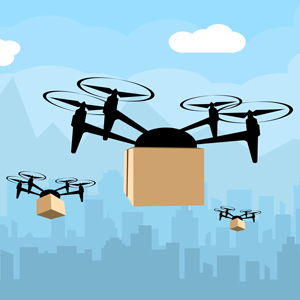
Once the domain of the military and hobbyists, the market for unmanned aerial vehicles (UAVs), or drones, now encompasses a wide range of commercial applications and is expected to hit more than US$21 billion by 2022. This spells opportunity for the semiconductor industry: sensors are needed to help drones fly steadily and detect altitude, GPS enables them to know where they are and avoid crashes, and semiconductor chips provide the processing power needed for transmitting images and data in real-time. Thermal imaging, LIDAR (light detection and ranging), cameras, and lasers are additional functionalities that can be incorporated into drones. These tiny feats of engineering are enabling a new world of possibilities.
Dropping Packages from Above
For some time, major retailers and postal services have been gearing up for deliveries by drone. The Amazon Prime Air service, designed to deliver packages up to 5 pounds within 30 minutes, is undergoing private trials in the U.K. In May 2017, the company also received a patent from the US Patent & Trademark Office to drop packages by parachute to your doorstep.
Drones are already being used for deliveries of a more critical nature. Swiss Post is partnering with California-based drone company Matternet in a test program approved by the Swiss Aviation Authority to fly lab samples between two hospitals, with hopes for this to be standard practice by 2018. The country of Rwanda is partnering with San Francisco start-up Zipline to use fixed-wing drones (that look like small airplanes) to deliver emergency blood and medical supplies to hospitals, significantly cutting emergency delivery times. Other humanitarian uses include surveying disaster zones and assisting search and rescue operations in areas that aren’t easily accessible by traditional vehicles.
Our Eyes in the Sky
Drones can help keep inspectors and operators safe during inspections on oil and gas lines, bridges, wind turbines, and power lines. Beyond visual line-of-sight (BVLOS) flights expand the possibilities. Laserpas, a commercial drone operator licensed for BVLOS in Lithuania, Latvia, Poland, Bulgaria, and Romania, has carried out over 3,000 km (~1,864 miles) of powerline network inspections, while Lockheed Martin has also carried out BVLOS test flights on pipelines and wellheads in Canada.
The Precision Agriculture revolution, which currently uses satellites to collect and process farming data in real-time, is beginning to turn to drones as an alternative. Relatively fast, cheap, and capable of more detailed map resolution, they are already being used in Australia to assess crop health through infrared mapping. Researchers at Harper Adams University in the U.K. are also testing drone capabilities for seeding and spraying to enable more economic crop management in locations where traditional methods can’t be used.
Delivering People
For the brave of heart, drones could soon be an option to replace that dreaded commute. The world’s first passenger drone from Chinese company EHang was ready for take-off across Dubai in July 2017. Passengers tap their destination into the cockpit, and the drone uses a camera to ensure a safe landing. Meanwhile, Uber is planning for self-flying drone taxis using fixed wing aircraft with “vertical take-off and landing” (VTOL) technology. Just goes to show this technology is not just for packages anymore!
Read other articles in this series:
- Silicon Snack: Technology in Medicine Is Just What the Doctor Ordered
- Silicon Snack: eSports Are Taking the Field
- Silicon Snack: AR/VR Changing How We Learn
- Silicon Snack: Precision Farming Fueled by Big Data
- Silicon Snack: Pilotless Passenger Jets More than a Blue-Sky Idea
- Silicon Snack: Brushing Up on Art Restoration
- Silicon Snack: On the Ball with Sports Tech
- Silicon Snack: Robots Get Social
- Silicon Snack: Stepping Out with Smart Shoes
- Silicon Snack: Food Preparation – Taste the Future
Editorial Note: The use of any company, product, or trade names is for descriptive purposes only and does not imply endorsement by Lam Research Corp. or its subsidiaries.